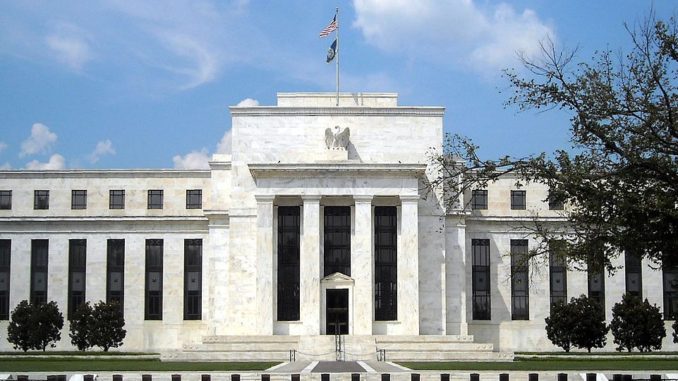
On Tuesday, with the mid-term election looming, President Trump renewed his attack on both the Federal Reserve’s monetary policy course and Federal Reserve Chairman Jerome Powell. In an interview with The Wall Street Journal, he said that the Federal Reserve poses the “biggest risk” to the nation’s economy.
The Wall Street Journal reported of President Trump’s latest attack on Federal Reserve Chair Jerome Powell:
The Republican president’s caustic comments about Mr. Powell came as Mr. Trump repeatedly described the economy in personal terms. He referred to economic gains during his time in office as “my numbers,” saying, “I have a hot economy going.” He described his push for growth as a competition with former President Obama’s record, saying that increases in growth under his Democratic predecessor were skewed because of low interest rates…
“To me, the Fed is the biggest risk, because I think interest rates are being raised too quickly,” Mr. Trump said just before he pushed a red button on his desk, summoning an iced cola delivered to him on a silver platter…
Asked why he thought Mr. Powell was raising rates, Mr. Trump paused, then said, “He was supposed to be a low-interest-rate guy. It’s turned out that he’s not.”
Mr. Trump demurred when asked under what circumstances he would remove Mr. Powell, whom he selected for a four-year term that started in February. “I don’t know,” he said. “I’m just saying this: I’m very unhappy with the Fed because Obama had zero interest rates.”
President Trump’s comments display a lack of understanding as to why the Fed slashed its benchmark rate to historically low levels and then, afterward, maintained that rate for an extended period of time. Such context is crucial to understanding the central bank’s monetary policy decisions.
The Federal Reserve reduced the target federal funds rate to 0.00% to 0.25% on December 16, 2008 due to the combination of a severe financial crisis and rapidly deteriorating economy. The Federal Reserve’s transcript from the two-day meeting, which commenced on December 15, records that Federal Reserve Chair Ben Bernanke noted “extraordinary circumstances” affecting the nation’s economy. Bernanke explained:
As you know, we are at a historic juncture–both for the U.S. economy and for the Federal Reserve. The financial and economic crisis is severe despite extraordinary efforts not only by the Federal Reserve but also by other policymakers here and around the world…
It’s not a moderate recession, and it’s not a normal financial downturn…
You have a deep recession and a financial crisis. That’s pretty unusual. Twice a century, or once a century so far.
Approximately five years later, the Federal Reserve reaffirmed that target interest rate on December 18, 2013. The minutes from that meeting revealed:
The staff viewed the uncertainty around the projection for economic activity as similar to its average over the past 20 years. Nonetheless, the risks to the forecast for real GDP growth were viewed as tilted to the downside, reflecting concerns that the extent of supply-side damage to the economy since the recession could prove greater than assumed; that the tightening in mortgage rates since last spring could exert greater restraint on the housing recovery than had been projected; that economic and financial stresses in emerging market economies and the euro area could intensify; and that, with the target federal funds rate already near its lower bound, the U.S. economy was not well positioned to weather future adverse shocks.
Much has changed since then. For example, the minutes from its September 25-26, 2018 meeting after which the Fed hiked its target rate by 25 basis points to 2.00% to 2.25% explained:
The information reviewed for the September 25-26 meeting indicated that labor market conditions continued to strengthen in recent months and that real gross domestic product (GDP) appeared to be rising at a strong rate in the third quarter, similar to its pace in the first half of the year…
The staff viewed the uncertainty around its projections for real GDP growth, the unemployment rate, and inflation as similar to the average of the past 20 years. The staff also saw the risks to the forecasts for real GDP growth and the unemployment rate as balanced. On the upside, household spending and business investment could expand faster than the staff projected, supported in part by the tax cuts enacted last year. On the down-side, trade policies and foreign economic developments could move in directions that have significant negative effects on U.S. economic growth. Risks to the inflation projection also were seen as balanced.
All said, in maintaining historically low interest rates for an extended period of time, the Federal Reserve was acting prudently in the face of the economic data of the time and the U.S. economy’s lack of ability to withstand shocks. Today, the U.S. economy is sufficiently strong that the fragility following the end of the Great Recession is no longer present. Therefore, the Federal Reserve is in a position to gradually normalize monetary policy.
President Trump’s implication notwithstanding, the Federal Reserve was not acting politically in maintaining low interest rates throughout much of President Obama’s tenure. It was making its decisions based on the available data at the time. Its chief purpose was to give the economic recovery the time it needed to gain traction and a capacity for resiliency.
Maintaining similar interest rates today when the unemployment rate is arguably at levels consistent with full employment, GDP is experiencing a fiscal-stimulus-driven burst in growth, and wages have begun to increase at faster rate, would risk an increase in inflation and inflation expectations. Facilitating such risks would be inconsistent with the Fed’s longer-term monetary policy goals.
